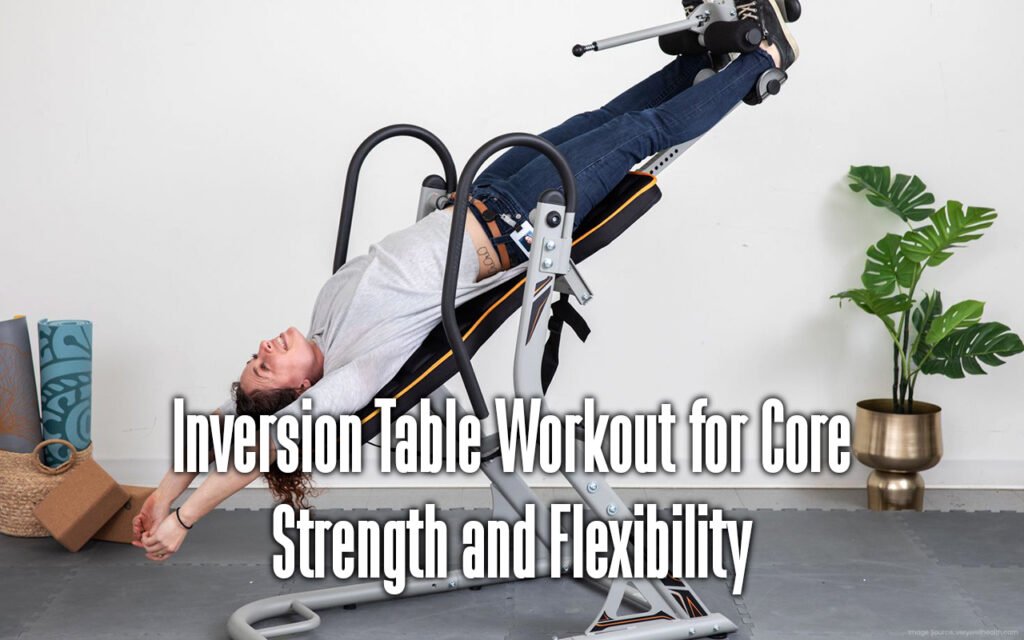Individuals often explore various workout methods in the quest for a strong and flexible body. One intriguing approach that has gained popularity is using inversion tables to enhance core strength and flexibility. Inversion table workouts uniquely engage the core muscles while promoting spinal health and overall well-being. In this article, we will delve into the benefits of inversion table exercises, explore different workout routines, and provide safety considerations for those looking to incorporate this practice into their fitness regimen.
Understanding Inversion Tables
Table of Contents
An inversion table is a specialized piece of equipment that allows a person to be suspended upside down in various degrees of inversion. This practice is based on the concept of spinal decompression, where the force of gravity is utilized to elongate the spine and relieve pressure on the intervertebral discs. This decompression promotes improved circulation, reduces muscle tension, and alleviates back pain. In addition to its potential therapeutic benefits, inversion tables have gained recognition as a tool for engaging the core muscles and increasing flexibility.
Benefits of Inversion Table Workouts
Core Strengthening
Inversion table workouts offer a dynamic and engaging way to target the core muscles. As you invert, the abdomen, obliques, and lower back muscles are required to contract to maintain stability and balance. Constant engagement of core muscles helps to strengthen them over time. A strong core is important for maintaining good posture & preventing back pain. Still, it also plays a pivotal role in supporting the spine during everyday activities and more intense workouts.
Spinal Decompression and Alignment
One of the most significant advantages of inversion table workouts is their effect on spinal decompression. When inverted, the gravitational force helps to elongate the spine by creating space between the vertebrae. This can relieve the pressure on the intervertebral discs, allowing them to rehydrate and regain their natural shape. As a result, compressed discs are given a chance to recover, potentially reducing pain caused by conditions like herniated discs or sciatica. Additionally, the spine’s elongation during inversion can contribute to better spinal alignment, improving posture and reducing the risk of chronic pain.
Enhanced Flexibility and Range of Motion
Regular use of an inversion table increases flexibility and improves range of motion. Individuals may find it easier to perform various stretches and movements as the spine elongates and the muscles surrounding it relax during inversion. This increased flexibility not only helps in day-to-day activities but can also be beneficial for athletes to improve their performance and prevent injuries. Moreover, enhanced flexibility can contribute to joint health by promoting proper lubrication and reducing the risk of stiffness.
Improved Blood Circulation
Inversion table workouts have the potential to enhance blood circulation throughout the body. When inverted, blood flow to the brain increases due to the pull of gravity. This increased blood circulation delivers essential oxygen and nutrients to the brain cells, which can improve cognitive function and mental clarity. Additionally, improved circulation can promote better nutrient delivery and waste removal throughout the body, aiding overall cellular health.
Lymphatic System Support
Lymphatic system support plays an important role in the immune system, removing waste products and toxins from the body. Inversion table workouts can help stimulate the lymphatic system, promoting the efficient drainage of lymphatic fluid. This can aid in detoxification and support a healthier immune response.
Muscular Relaxation and Stress Relief
The sensation of being inverted can have a calming effect on the nervous system, which leads to muscular relaxation and stress relief. As the muscles elongate and tension is released during inversion, individuals often experience a sense of physical and mental peace. This relaxation reduces stress and anxiety, allowing for improved mental well-being.
Pain Management and Rehabilitation
Inversion table workouts are part of pain management and rehabilitation programs. Individuals with chronic back pain, muscle spasms, or other musculoskeletal issues may find relief through the decompression and relaxation experienced during inversion. However, it’s important to consult a healthcare professional before using inversion therapy as part of a pain management strategy.
Improved Digestion
Inversion table exercises can improve digestion and alleviate specific gastrointestinal issues. The gentle pressure applied to the abdomen during inversion can aid food movement through the digestive tract, promoting more efficient digestion and reducing bloating.
Post-Workout Recovery
Inversion table workouts can be incorporated into a post-workout recovery routine. The decompression and relaxation provided by inversion can help reduce muscle soreness and tension after a strenuous workout, allowing for quicker recovery.
Mood Enhancement
The physical benefits of inversion table workouts often translate into improved mental well-being. The release of endorphins, often called “feel-good” hormones, during inversion can uplift mood and contribute to a sense of overall positivity.
Inversion Table Workout Routines
Incorporating inversion table workout into your fitness routine can be fun and effective. Here are some workout routines that target core strength and flexibility:
Inversion Stretch
- Start with a gentle inversion angle, such as 30 degrees.
- Hold the inversion for 1-2 minutes to allow the spine to elongate and muscles to relax.
- Engage your core muscles to maintain control and stability.
- Perform deep breathing exercises while inverted to promote relaxation.
- Gradually increase the inversion angle as your comfort level and experience grow.
Leg Raises
- Securely fasten your feet to the inversion table’s ankle locks.
- Invert to a comfortable angle.
- Engage your core muscles & lift your legs towards the ceiling.
- Lower your legs back down & repeat for a set of 10-15 repetitions.
- Focus on controlled movements and proper form to avoid strain.
Twist
- Invert to a moderate angle.
- Place your hands behind your head or cross your arms over your chest.
- Engage your core and slowly twist your upper body to the left, then to the right.
- Perform 10-12 twists on each side, focusing on the oblique muscles.
- Keep your workout movements controlled, and avoid jerking or using momentum.
Reverse Plank
- Begin with a shallow inversion angle.
- Position your hands on the sides of the body and lift your body into a plank position.
- Engage your core & maintain the straight line from head to heels.
- Hold the plank for 30 seconds minute, gradually increasing the duration as you progress.
Stretching
- Set the inversion table to a gentle angle.
- Use the inversion to facilitate various stretches, such as hamstring stretches or spinal twists.
- Hold each stretch for 20-30 seconds, breathing deeply and allowing your muscles to relax into the stretch.
- Experiment with different stretches to target different muscle groups.
Incorporating Inversion Table Workouts into Your Routine
It’s important to integrate them strategically into your existing fitness routine to make the most of inversion table exercises for core strength and flexibility. Here’s a comprehensive guide on how to effectively incorporate inversion table workouts into your weekly schedule:
Set Clear Goals
Define your fitness goals before incorporating inversion table workouts. Are you aiming to improve core strength, enhance flexibility, alleviate back pain, or achieve a combination of these benefits? Having clear objectives will help you tailor your routine accordingly.
Warm-Up Routine
Just like any other workout, it’s crucial to prepare your body for inversion table exercises with a proper warm-up. Perform dynamic stretches that target your core, lower back and hamstrings. This helps increase blood flow, lubricate joints, and reduce the risk of injury.
Choose the Right Timing
Inversion table workouts can be invigorating, but they can also be intense. Opt for a time in your day when your energy levels are relatively high and your body is well-rested. Avoid immediately after heavy meals or when you’re fatigued.
Balance with Other Exercises
Inversion table exercises can be an excellent addition to your overall fitness routine, but they should not replace other essential components like cardiovascular exercises, strength training, and flexibility work. Incorporate inversion table exercises as a supplementary element rather than the sole focus.
Plan Your Sessions
Design your inversion table sessions to be balanced and comprehensive. Include various exercises that target different muscle groups, including core-specific exercises, back stretches, and twists. This diversity ensures that you’re reaping the benefits of a well-rounded workout.
Gradual Progression
Start with a shallow inversion angle and gradually increase it as your body adapts to the sensation. Similarly, begin with a lower intensity and fewer repetitions, then progressively increase both the intensity and volume over time. This approach minimizes the risk of discomfort or injury.
Post-Workout Stretches
After your inversion table workout, perform static stretches to enhance flexibility further and prevent muscle tightness. Focus on stretches for the core, hamstrings, hip flexors, and back muscles. This cooldown routine aids in recovery and supports long-term flexibility gains.
Listen to Your Body
Your body’s response to inversion table exercises may vary. Pay attention to how your body feels during and after each session. If you experience any discomfort, dizziness, or unusual sensations, stop immediately and consult a medical professional if necessary.
Hydration and Nutrition
Inversion table workouts can increase blood flow to the head, potentially affecting hydration levels. Stay well-hydrated before, during, and after your workouts. Additionally, maintain a balanced diet to provide your body with the nutrients it needs to support muscle recovery and overall health.
Rest and Recovery
As with any form of exercise, adequate rest and recovery are crucial. Give your body time to recuperate between inversion table sessions. Overtraining can lead to muscle fatigue and potential injury, so ensure you have rest days in your routine.
Long-Term Consistency
Consistency is key to seeing sustainable results. Incorporating inversion table exercises into your fitness routine should be a long-term commitment. Track your progress, celebrate milestones, and adjust as needed to keep challenging your body.
Safety Considerations
While inversion table workouts offer numerous benefits, it’s important to prioritize safety. Here are some considerations to keep in mind:
Consult a Healthcare Professional
Before incorporating inversion table workout into your fitness routine, consult a healthcare professional, especially if you have any pre-existing medical conditions. Conditions such as high blood pressure, heart problems, glaucoma, and certain spine-related issues might affect your suitability for inversion therapy.
Follow the Manufacturer’s Instructions
Read and thoroughly understand the manufacturer’s instructions for setting up, using, and maintaining the inversion table. Improper setup or usage can lead to accidents or injuries.
Proper Setup and Stability
Ensure that the inversion table is set up on a stable and level surface. The table should be secure and not wobble during use. Double-check that all locking mechanisms and adjustments are correctly fastened before getting on the table.
Listen to Your Body
Pay close attention to how your body responds during inversion. If you experience dizziness, lightheadedness, discomfort, or any unusual sensations, stop the inversion immediately and return to an upright position.
Avoid Full Inversion if Unsuitable
Only some people are suited for full inversion, and others might find partial inversion angles more comfortable and safe. You can still reap the benefits of inversion therapy by finding an angle that feels right for you.
Proper Attire
Wear comfortable and non-restrictive clothing when using the inversion table. This will ensure that your movements are not hindered and you can maintain proper form during exercises.
Proper Foot and Ankle Locking
Securely fasten your feet in the ankle locks according to the manufacturer’s instructions. Incorrect or loose fastening can lead to accidents during exercises.
Avoid Sudden Movements
Perform all movements on the inversion table slowly and deliberately. Avoid sudden jerking or swinging motions, as these can strain muscles and increase the risk of injury.
Time Limits
Start with short inversion sessions, typically around 1-2 minutes, especially if you’re new to inversion therapy. Gradually increase the duration as you become more comfortable and experienced.
Partner Assistance
If you’re new to inversion therapy, having a partner nearby can be helpful for added safety. They can assist you in returning to an upright position if needed.
Quality of the Inversion Table
Invest in a high-quality inversion table from a reputable manufacturer. Cheap or poorly constructed tables might compromise your safety and overall experience.
Pregnancy and Medical Conditions
Pregnant individuals and those with certain medical conditions, such as hernias, cardiovascular issues, or retinal detachment, should avoid inversion therapy. Always consult with the healthcare provider before attempting any inversion exercises.
Conclusion
Inversion table workouts provide a unique and engaging way to enhance core strength, flexibility, and overall well-being. Individuals can experience improved spinal health, increased flexibility, and a sense of relaxation by incorporating exercises that target the core muscles and promote spinal decompression. However, it’s essential to prioritize safety, consult a healthcare professional if necessary, and follow proper guidelines for usage and progression. An inversion table workout can be a valuable addition to your fitness routine, contributing to a strong, flexible, and healthy body.
Incorporating inversion table workouts can positively impact core strength, flexibility, and overall well-being. Safety and proper technique should always take precedence. Discover the top inversion tables of 2024 to enhance your inversion therapy experience. Check out our comprehensive guide, ‘8 Best Inversion Tables of 2024‘. This guide offers detailed reviews and insights to assist you in making an informed decision on the perfect inversion table for your requirements. Discover the benefits of inversion therapy for your fitness and spinal health. Explore expert recommendations to elevate your experience by reading the full article here.








